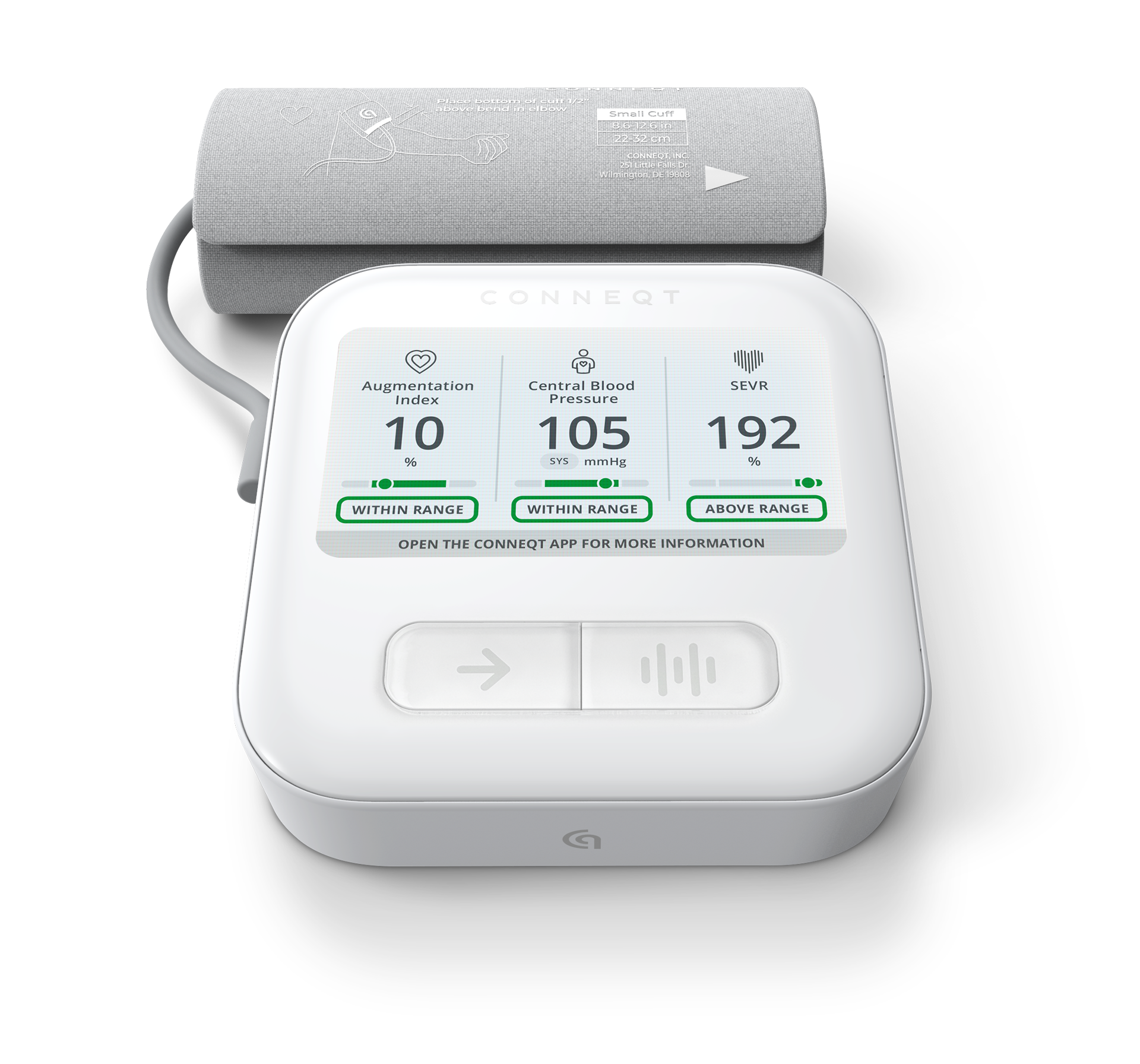If you’ve had a calcium score test, also known as a coronary artery calcium (CAC) score, you might think you have a complete picture of your heart health—but it only tells part of the story. A calcium score detects hardened plaque that has already formed, but it doesn’t measure hidden risks that could lead to future heart disease. Long before plaque builds up, your arteries may already be stiffening and elevated central blood pressure could be silently putting strain on your heart—two significant risk factors for future calcification.
In a Heartbeat
- Both soft and hard plaque are indicators of coronary artery disease and cardiovascular risk.
- Hard (calcified) plaque can be detected with a calcium score—but once formed, it’s irreversible.
- Soft plaque cannot be detected by a calcium score but may signal early cardiovascular risk if not reversed.
- Measuring arterial stiffness with the CONNEQT Pulse helps identify cardiovascular risk earlier—by detecting stiffness caused by both soft and hard plaque that a calcium score may miss.
- A person with a calcium score of 0 (meaning no hard plaque) but elevated arterial stiffness—such as a high augmentation index (AIx)—may still face high cardiovascular risk. This elevated stiffness may be caused by soft plaque that remains undetected by calcium scoring, highlighting the importance of measuring arterial function alongside plaque imaging.
- A calcium score of 0 does not mean zero risk.
A zero calcium score does not mean zero risk. Many people with a low or zero score still develop cardiovascular disease because traditional testing misses key warning signs. Arterial stiffness, high central blood pressure, and increased heart strain—all of which a calcium score test does not measure—can increase your risk, even if your calcium score is zero.

Measure what matters
Save 20% on checkout with code VITALITY
What a Calcium Score Won’t Tell You
The Risk of Calcification—Before It Happens
Plaque in the coronary arteries begins as soft plaque and becomes harder and calcified over time. A calcium score test provides a snapshot of coronary artery disease and identifies hard plaque that has already formed. But plaque doesn’t appear overnight; it develops first as soft plaque due to conditions like hyperlipidemia, obesity, diabetes, hypertension, smoking, and even your genetics. Soft plaque is high in lipids and is not calcified.
As soft plaque builds in the arteries, it starts the process of vascular dysfunction and causes arterial stiffness. A calcium score does not measure soft plaque or arterial stiffness and misses the opportunity to identify vascular dysfunction in its early stages, before heart disease is present. It’s important to know that plaque can be prevented and even reversed in the early stages, but once plaque hardens, it cannot be reversed and increases your risk of heart disease.
In simple terms, consider the pipes in your home:
- Blockages build up slowly and start first as soft blockages. These blockages are caused by many “unhealthy” factors. If identified early, these blockages can be reversed. This would be soft plaque in the coronary arteries.
- Over time, these soft blockages become harder and narrow the inside of the pipe. The pipe becomes stiff and causes problems with the flow of water. Once hard blockages are there, they cannot be reversed. This would be hard plaque in the coronary arteries that causes heart disease.
The goal of prevention is to lower cardiovascular risk. While a calcium score is important, it does not identify these very early stages. CONNEQT Pulse measures arterial stiffness, central blood pressure, and circulatory efficiency. These measurements start to change before plaque develops. Knowing if you have arterial stiffness or high central blood pressure can identify your cardiovascular risk well before heart disease occurs. This is particularly important even if your calcium score is zero. A zero score does not mean zero risk.
How Stiff Your Arteries Are
Healthy arteries expand and contract to keep blood flowing smoothly. But over time, they can lose flexibility, making it harder for blood to circulate efficiently. A calcium score test does not assess arterial stiffness, even though it plays a critical role in hypertension, heart disease, and stroke risk. Once plaque hardens, the damage is often irreversible, making early detection of arterial stiffness essential. Even with a zero calcium score, stiff arteries can put you at risk.
The Pressure Your Heart Feels
Blood pressure readings at the arm (brachial blood pressure) don’t tell the whole story. Central blood pressure (CBP) measures the force placed on the arteries closest to the heart, offering a more accurate reflection of cardiovascular strain. A calcium score does not capture how much pressure your heart is working against with each beat.
How Hard Your Heart is Working
As arteries stiffen, blood pressure waves bounce back toward the heart, forcing it to work harder than normal. This added strain isn’t reflected in a calcium score test, even though it can signal increased cardiovascular risk. By measuring augmentation pressure (AP) and augmentation index (AIx), arterial stiffness can be detected before plaque begins to form and well before hard, calcified plaque, helping identify risks earlier.
This matters because individuals with zero calcium scores but elevated stiffness may still be at risk due to undetected soft plaque. Research, such as the MESA study, has shown that people with high arterial stiffness but zero CAC were still more likely to develop cardiovascular events—like a heart attack or stroke—potentially due to the presence of soft plaque.
The Hidden Impact of Circulatory Efficiency
Your arteries don’t just move blood—they supply oxygen and nutrients to vital organs like the heart, brain, and kidneys. Central pulse pressure (CPP) assesses how well blood flows through the body, something a calcium score test does not measure. Tracking CPP can reveal inefficiencies that impact long-term cardiovascular health—even if no plaque is present.
The table below highlights the key differences between a calcium score test and arterial stiffness measurements, helping to clarify how each test contributes to cardiovascular risk assessment.

Understanding Augmentation Pressure (AP) and Augmentation Index (AIx)
What Are AP and AIx?
Before plaque becomes detectable, arterial stiffness can already be developing, increasing strain on the heart. Augmentation Pressure (AP) and Augmentation Index (AIx) provide key insights into this process, making them essential for early cardiovascular risk assessment.
- Augmentation Pressure (AP): The extra force the heart must generate to pump blood due to stiffened arteries.
- Augmentation Index (AIx): The percentage of total blood pressure that results from this added force.
Higher AP and AIx indicate greater arterial stiffness, increased heart strain, and elevated cardiovascular risk—even in individuals with a zero calcium score.
AP and AIx measure arterial stiffness and vascular dysfunction from early stages all the way to late stages of heart disease. While AP and AIx do not differentiate whether stiffness is due to soft or hard plaque, they do more accurately measure your cardiovascular risk—specifically when the calcium score is zero. When arterial stiffness is present in people with a calcium score of zero, their cardiovascular risk may, in fact, be high because of soft plaque that the calcium score did not pick up.
A zero score does not mean zero risk. AP and AIx help to better and more accurately identify your cardiovascular risk.
Why Are These Measurements Important?
Unlike a calcium score, which only measures past damage, AP and AIx provide a real-time view of arterial stiffness. Since these measurements can be tracked over time, they offer valuable insight into cardiovascular health trends.
Regular testing can help:
- Detect early arterial stiffening before plaque forms and coronary artery disease develops.
- Evaluate the impact of lifestyle changes, diet, exercise, and medications on vascular health.
- Identify hidden risks that a calcium score test does not capture, providing a more complete and proactive assessment of cardiovascular health.
Tools like the CONNEQT Pulse measure arterial stiffness noninvasively and can help detect early vascular dysfunction before calcified plaques appear on CT. That makes them uniquely positioned to identify the early stages of vascular dysfunction, which can be modified and even reversed. This is important, especially in people whose CAC score is zero but whose cardiovascular risk is not.
A Smarter Approach to Cardiovascular Health
A calcium score only measures past damage, but your heart health is constantly changing. The CONNEQT Arterial Health Assessment provides a real-time, at-home evaluation of vascular function and cardiovascular risk, allowing you to track changes over time and take a proactive approach to heart health.
Unlike a coronary calcium score, CONNEQT’s advanced arterial health technology can:
- Detect early arterial dysfunction before plaque develops.
- Measure arterial stiffness, a key risk factor for heart disease.
- Evaluate central blood pressure (CBP) to assess direct heart strain.
- Identify hidden cardiovascular risks, even if a calcium score is low.
- Track vascular health trends over time to measure the impact of lifestyle changes.
- Provide Baseline, On-Demand, and Cardiology Reports with actionable insights you can share with your care team.
Using the CONNEQT Pulse biometric monitor, you can take multiple readings, which seamlessly sync to the CONNEQT Health app. There, Arterial Intelligence™ translates your data into clear, digestible insights, providing personalized cardiology reports, in-depth health analysis, and long-term tracking to support both your health journey and your physician’s decision-making.
With FDA-cleared, clinically validated technology, the CONNEQT Arterial Health Assessment goes beyond traditional tests—offering continuous monitoring of arterial health instead of a single snapshot. By tracking arterial stiffness and central blood pressure, it gives you a more complete and dynamic view of your cardiovascular health—far beyond what a calcium score test alone can provide. With CONNEQT’s Arterial Intelligence™, you can take control of your heart health today—without waiting for symptoms to appear.






